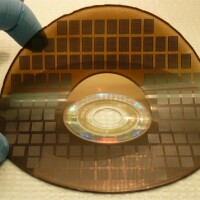Advance Made in Super 'Batteries' Might Take Us Closer to a More Sustainable Future

We reported in February about research into using graphene, an inexpensive, biodegradable form of pure carbon as a possible way to store electrical power cheaply and without much environmental impact.
A new study suggests that pairing that carbon with the second most common element in the Earth's crust, silicon, may offer a way to produce efficient, durable power storage at a low price.
We're talking about supercapacitors, the high-tech mini storage systems that can in theory charge hundreds of times faster than batteries, with thousands of times more charge cycles in their usable life span. And a team of engineering researchers from Vanderbilt University has found a way to combine graphene and silicon to make supercapacitors store up to forty times more power than commercially available models.
If supercapacitors take much less time to charge than lithium ion batteries and last through thousands of times as many charge cycles, why are we still waiting for hours to charge old-school batteries in our smartphones? Simple: it's because the actual power storage capacity of batteries is still much higher than that of available supercapacitors. Even with recent advances in technology, supercapacitors can only store about two to five percent as much power as a lithium battery of similar weight.
Which means that even though a smartphone using commercially available supercapacitors instead of batteries might only take a minute or two to charge fully, you'd end up needing to recharge it at least once an hour. That would hardly make your supercapacitor smartphone competitive in the marketplace, obligatory jokes about battery use in iOS 7 aside.
Not that we don't use supercapacitors in everyday life already: even though they don't store a huge amount of power, they're very useful for things like regulating current in sensitive electronics. But every incremental increase in supercapacitor capacity opens up potential for new uses, perhaps eventually including things like replacing large batteries in electric cars.
Researchers have long eyed silicon as a base material for possible use in supercapacitors. The more surface area there is on a supercapacitance medium, the more electrons it can store. as a result of billions of dollars of R&D investment from the tech industry, we can create silicon surfaces with staggeringly high amounts of surface area on microscopic texture features, tiny little holes and protrusions that add to the silicon's surface-to-volume ratio. But silicon is highly reactive: it tends to combine with available ions, which fill up all the surface area that would have been suitable for electron storage. As electrochemical supercapacitors include electrolyte solutions, which are essentially a soup of ions, that would seem to rule out silicon as a base for supercapacitor electrodes
In a paper published last week in Nature Scientific Reports, Vanderbilt University's Cary Pint and colleagues created model supercapacitors with porous silicon electrodes, and then grew a thin coat of graphene on those silicon surfaces.
Graphene, which is relatively unreactive, served as a barrier between the silicon and the electrolyte solution. And as graphene is a good conductor, electrons could flow through the graphene "raincoat" to be stored on the silicon electrodes.
The result? The graphene-coated electrodes stored substantially more power per gram than commercially available supercapacitors can.
Pint et al have high hopes for their findings; the paper's abstract refers to the possibility of "a promising new platform for grid-scale and integrated electrochemical energy storage."
In other words, this may offer a way to store solar energy until it's needed at night. Gizmag quotes the team as suggesting that "supercapacitors built out of the silicon in the back side of solar cells could store energy during the day and gradually release it into the energy grid during the hours of peak consumption."
As always, the proof is in the implementation. Lots of exciting advances never make it out of the lab. But we'll be watching.





